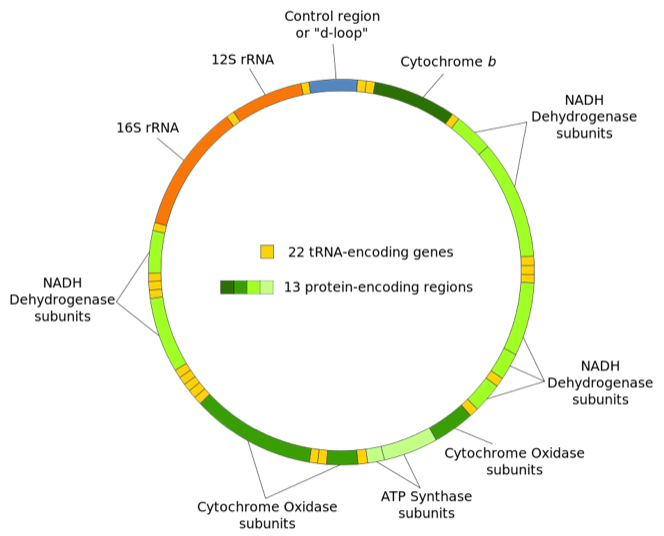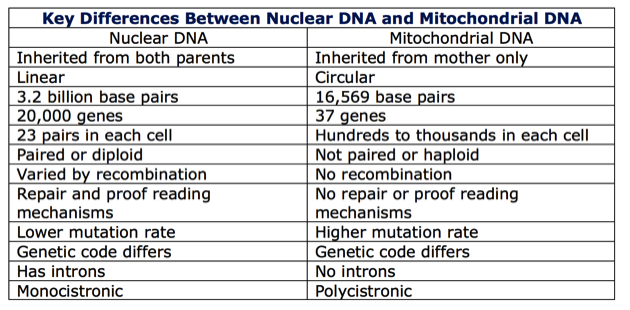
Mitochondrial DNA
Nuclear DNA is inherited from both parents. However, all the mitochondria for an individual is provided by the egg cell meaning that all mitochondrial DNA is inherited only from one’s mother.
Nuclear DNA resides only in the membrane bound cell nucleus (of a prokaryotic cell) whereas mitochondrial DNA molecules are found in the mitochondria which are scattered throughout the cell cytoplasm.
Nuclear DNA is organized into linear strands that make up the 23 pairs of chromosomes in the human genome. There are about 3.2 billion base pairs in the nuclear DNA of a cell. Buried in these linear strands are about 20,000 genes that code for proteins along with other sections that control which genes are expressed in each cell and when. (Other areas of nuclear DNA may have yet undiscovered functions.)

By Andreas Bolzer, Gregor Kreth, Irina Solovei, Daniela Koehler, Kaan Saracoglu, Christine Fauth, Stefan Müller, Roland Eils, Christoph Cremer, Michael R. Speicher, Thomas Cremer [CC BY 2.5 (http://creativecommons.org/licenses/by/2.5)], via Wikimedia Commons.
Mitochondrial DNA is circular in shape and contains only about 16,569 base pairs. There are only 37 genes and a “non-coding” region (also called the D loop) that does not code for any gene products (protein, various forms of RNA). Of the 37 genes, 22 code for transfer RNA, two code for ribosomal RNA and 13 code for proteins that are necessary for cellular energy production. (The mitochondria are not totally autonomous. Most of the proteins necessary for their function are coded by nuclear DNA.)

By derivative work: Shanel (talk) Mitochondrial DNA de.svg: translation by Knopfkind; layout by jhc (Mitochondrial DNA de.svg) [GFDL (http://www.gnu.org/copyleft/fdl.html) or CC-BY-SA-3.0 (http://creativecommons.org/licenses/by-sa/3.0/)], via Wikimedia Commons
Each cell contains only 23 pairs of chromosomal DNA. A cell may have tens to hundreds of mitochondria each with hundreds (or more) of DNA molecules. For example, the average human liver cell contains more than a thousand mitochondria each with hundreds of circular DNA molecules.
The chromosomes that comprise nuclear DNA are paired. Each member of a chromosome pair carries the same genes and codes for the same traits. (Differences in the nucleotide sequences of the genes are responsible for the variety of traits found in biological organisms.) We say that paired chromosomes are diploid. Though mitochondria have multiple copies of their circular DNA molecules, they are not paired and we say mitochondria are haploid.
When nuclear chromosomes are replicated during the process of creating new sex cells, cross-over or recombination between the members of the chromosome pairs insures variety and uniqueness to the new organism. No recombination occurs in mitochondrial DNA because there is no pairing.
Mitochondrial DNA lacks the repair mechanisms and proofreading capabilities that insure the integrity of the nuclear DNA during replication. This leads to a mutation rate for mitochondria that is about 10 times higher than for nuclear DNA.(reference http://www2.le.ac.uk/departments/emfpu/to-be-deleted/explained/mitochondrial)
Unlike nuclear DNA, mitochondrial DNA is densely packed with functional genes with no duplicates for back up in case one gene is disrupted by mutation. Mutations in these coding areas will result in mitochondria deficient in gene products (proteins mostly) necessary to their function. They will most likely be unable to reproduce and pass on their mutated genes. Consequently, despite the high mutation rate, the functional part of the mitochondrial genome varies slowly among individuals over time. In contrast, mutations in the control or non-coding region of mtDNA do no harm to the mitochondria nor do they affect the survival of the organism. They accumulate and are passed down through the maternal line. These mutations provide a source of variability that is useful in human identity testing and in investigating evolutionary and genealogical relationships.
The mitochondrial genetic code differs some from the code of nuclear DNA. For example, in mitochondria, the triplet codon AUA codes for the amino acid methionine whereas the same codon in nuclear DNA codes for isoleucine. Similarly the mitochondrial triplet UGA codes for tryptohphan and is NOT a STOP condon as it is in the nuclear DNA. (For more about the DNA code see the section about Gene Expression.)
Nuclear DNA has long stretches of non-coding DNA that is interspersed throughout the genome—sometimes even separating nucleotide sequences that code for a specific protein. These nonfunctional, nuclear DNA segments are called introns. (The coding sections are called exons.) Introns make up as much as 93% of nuclear DNA. Mitochondrial DNA has no introns. In fact, it appears that only 55 base pairs of mitochondrial DNA have no known function.
Nuclear DNA produces messenger RNA that codes for only one protein. (See the section Gene Expression.) If there are more than one polypetide chains coded for in a consecutive string of nuclear DNA nucleotides the resulting mRNA is cut apart into separate mRNA’s before binding to a ribosome. Nuclear DNA is monocistronic meaning there is a separate strand of mRNA for each protein. Mitochondrial DNA has a scheme more like that of the eukaryotic cells responsible for its origin. If an uninterrupted segment of mitochondrial DNA that consecutively codes for say three proteins, is transcribed to mRNA, that mRNA is NOT cut into three different mRNA’s. Rather, the whole mRNA proceeds to bind to a ribosome where it is directs the formation of all three proteins. In contrast to nuclear DNA, mRNA is polycistronic meaning one strand of mRNA may be responsible for the production of more than one protein.
Differences Between Nuclear DNA and Mitochondrial DNA
